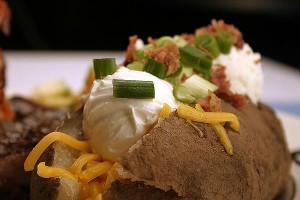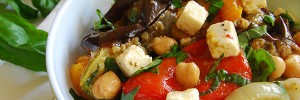Dry-Heat Preparation of Vegetables
Baking Vegetables
Some vegetables – especially potatoes, winter squash. onions, stuffed green peppers, and tomatoes – can be baked whole at approximately 350°F (177°C). Increasingly popular are roasted vegetables such as peppers, onions, and eggplant, which are generally sprinkled with oil and roasted at 375° to 425°F (191° to 218°C) until tender and well browned.
Potatoes are the most commonly baked vegetable and take approximately 1 hour, depending on their size and the oven temperature. Not all potatoes, however, lend themselves to baking. The starch content, density, and specific gravity of a potato determine whether it is a “boiler” or a “baker.” If a potato floats in a saline solution (1/2 cup salt in 5 1/2. cups water), it is best for simmering. If it sinks to the bottom, it is best for baking. Russet and Idaho varieties, which are “mealy” potatoes, have a high starch content and are good for baking and mashing, because they yield a dry, light, fluffy texture. When these potatoes are whipped, they readily incorporate air and soak up added milk and butter. Medium-starch potatoes, such as white potatoes. are all-purpose and are suited for both baking and simmering.
 Potatoes may be pierced with a fork before baking, or cooked for 20 minutes before piercing them to allow the steam to build up. Once in the oven, it is best to turn them every 20 minutes for even baking. Wrapping them in aluminum foil retains their moisture, resulting in a gummier potato, and produces a softer skin, which may or may not be desirable. Aluminum-foil-wrapped potatoes are steamed, in addition to being baked. Potatoes can be checked for doneness by squeezing them with an oven glove to see if they give in to pressure and feel soft under their skins. A fluffier potato results if the potato is massaged slightly before being slit open. Once opened, pushing both ends of the potato together plumps up the insides, making them still more fluffy and easier to empty.
Potatoes may be pierced with a fork before baking, or cooked for 20 minutes before piercing them to allow the steam to build up. Once in the oven, it is best to turn them every 20 minutes for even baking. Wrapping them in aluminum foil retains their moisture, resulting in a gummier potato, and produces a softer skin, which may or may not be desirable. Aluminum-foil-wrapped potatoes are steamed, in addition to being baked. Potatoes can be checked for doneness by squeezing them with an oven glove to see if they give in to pressure and feel soft under their skins. A fluffier potato results if the potato is massaged slightly before being slit open. Once opened, pushing both ends of the potato together plumps up the insides, making them still more fluffy and easier to empty.
Frying Vegetables
Vegetables can be stir-fried, pan fried, or deep-fat fried. Stir-frying combines a little oil with the vegetable’s natural moisture. For best results, tender, quick-cooking pieces like mushrooms are cut into large, uniform slices, while less tender pieces like carrots and celery are cut to expose the greatest amount of surface area to the heat. Although not necessary, a tight cover over the pan or wok will trap steam and reduce heating time, retaining maximum nutrients, color, and texture, although the vegetables will not brown as readily in the presence of trapped steam. The potato is the most commonly pan-fried of the vegetables. Deep-fat frying continues to be popular despite the associated increase in fat content. This is used especially for French fries, onion rings, and breaded zucchini. Russet and Idaho potatoes are preferred for French-frying and potato chips. Potatoes are selected for producing commercial potato chips based on the amount of sugars (specifically, reducing sugars) they contain: the less sugar, the more desirable the potato. These sugars contribute to excessive Mallard browning during frying and are considered a major quality defect. Other vegetables well suited for frying are mushrooms, long beans, broccoli florets, okra, and eggplant. An example of the latter is breaded fried eggplant with parmesan.
